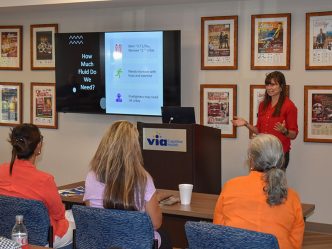If your child is in high school, a 2014 study from the Centers for Disease Control says there’s an almost 20 percent chance you are.
In a similar study published in 2013, researchers also found that students who had been bullied were 2.4 times more likely to report suicidal ideation and 3.3 times more likely to attempt suicide.
If it was a disease, bullying would be an epidemic of troubling proportions. Why, then, does it continue to plague grade schools across the country?
It’s complicated.
So says Dr. Darla Linville, assistant professor of Educational Foundations at Georgia Regents University.
“Traditionally, we’ve thought of bullying as repeated acts of intimidation against an individual or group,” Linville said.
In many ways, that description fits the caricature of the typical schoolyard terror – the uncaring, overbearing bully who makes life harder for his or her classmates – perfectly.
More recently, however, developmental researchers are beginning to characterize even single acts of targeted intimidation as bullying if they have a strong enough impact. The distinction is bringing a wider focus to bullying prevention.
It’s also blurring some previously established lines.
“It’s a hard thing to define,” Linville said. “Really, figuring out which acts can and can’t be characterized as bullying happens on a case-by-case basis. It’s complicated.”
According to Linville, bullying legislation and research now readily consider things like gossiping and isolating – the practice of intentionally depriving someone else of social opportunities – as acts of bullying. Other acts, she said, are somewhat tougher to label.
“When it comes to the kind of emotional harm associated with repeated denigrations of a person’s identity, things start to overlap with harassment,” Linville said. “Things like bullying someone for their race or their religion; those are considered dangerous conversations to have in school because they’re the kind of things that land schools in the news.”
The line between treating an incident as bullying or harassment is a tricky one. Unfortunately for modern educators, there’s almost no safe way to walk it.
“We don’t talk about gender harassment in schools,” Linville said. “We often don’t take on race or racial harassment. If we have a very small religious minority, a Jewish student or a Muslim student, we won’t talk about religious harassment in a very pointed or direct way. Those are considered political conversations, and that’s where the danger lies.”
The result is a bi-polar system in which bullying, already difficult to define, is further muddied by the nebulous definition of harassment. One is protected at the federal level, the other, protected by the states. Caught in the middle, teachers and school administrators are often left sitting on their hands, afraid to let acts of intimidation continue while also fearing national backlash should they overstep their bounds.
It’s a lose-lose situation.
Fortunately, though, it isn’t a hopeless one.
“There’s a lot of developmental reasons that students in middle school begin to point out the differences between themselves and others,” Linville said, noting the most common age group for bullying. “We as adults have to try to make schools a safe place for those differences to exist. We have to find a way for students to say ‘I’m not like that, but that’s okay.’”
The solution, Linville said, is for educators to resort to one of modern education’s staples: repetition.
“In all behavioral modification in schools, we have to repeat what we say over and over,” she said. “Adults in those spheres with young people have to keep repeating, ‘Yep, yep, that happened again, and yes you want to respond in kind, but we have to talk it through. Let’s keep talking it through.”
But educators aren’t the only ones who can help to put an end to bullying. Parents, and even students, have roles to play as well.
“Oftentimes students and young people want to try to resolve bullying on their own, and oftentimes that’s a great way to go,” Linville said. “If they feel like they can talk to their bully and resolve their differences and work out what was wrong, that’s great.”
Sometimes, though, that type of face-to-face resolution doesn’t work.
“Then it becomes necessary to ask for an adult to step in,” Linville said.
For parents and guardians newly acquainted with bullying, Linville had some great advice. Paying attention to available resources was at the top of her list. Sites like “Edutopia,” a comprehensive website and online community focused on K-12 education strategies, and “Great! Kids” offer a wealth of articles for parents and educators alike. Talking to school officials was another great option.
“Talking to someone, even if the problem can’t be resolved in the short term, is invaluable for children suffering from the effects of bullying,” she said.
She said that someone could be a teacher, a counselor or a school administrator. Ideally, though, Linville believes that someone should be a child’s parents or legal guardians.
“Talk to your children,” Linville said. “Even if the response you get is ‘Whatever,’ or ‘Leave me alone, mom,’ ask them how they’re feeling. Keep up to date with what’s happening in their lives and never be afraid to ask.”
She said that goes double for children’s online interactions.
“Be aware of what your children are doing on the web,” she said. “Watch over them. Be sure you know who they’re talking to.”
Smiling, Linville added, “Some might call that spying. I prefer to think of it as attentive parenting, showing you care.”
And that, more than anything, is what victims of bullying need most – someone to care.
 Augusta University
Augusta University



